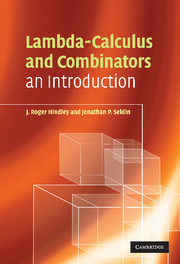Book contents
- Frontmatter
- Contents
- Preface
- 1 The λ-calculus
- 2 Combinatory logic
- 3 The power of λ and combinators
- 4 Representing the computable functions
- 5 The undecidability theorem
- 6 The formal theories λβ and CLw
- 7 Extensionality in λ-calculus
- 8 Extensionality in combinatory logic
- 9 Correspondence between λ and CL
- 10 Simple typing, Church-style
- 11 Simple typing, Curry-style in CL
- 12 Simple typing, Curry-style in λ
- 13 Generalizations of typing
- 14 Models of CL
- 15 Models of λ-calculus
- 16 Scott's D∞ and other models
- Appendix A1 Bound variables and α-conversion
- Appendix A2 Confluence proofs
- Appendix A3 Strong normalization proofs
- Appendix A4 Care of your pet combinator
- Appendix A5 Answers to starred exercises
- References
- List of symbols
- Index
15 - Models of λ-calculus
Published online by Cambridge University Press: 05 June 2012
- Frontmatter
- Contents
- Preface
- 1 The λ-calculus
- 2 Combinatory logic
- 3 The power of λ and combinators
- 4 Representing the computable functions
- 5 The undecidability theorem
- 6 The formal theories λβ and CLw
- 7 Extensionality in λ-calculus
- 8 Extensionality in combinatory logic
- 9 Correspondence between λ and CL
- 10 Simple typing, Church-style
- 11 Simple typing, Curry-style in CL
- 12 Simple typing, Curry-style in λ
- 13 Generalizations of typing
- 14 Models of CL
- 15 Models of λ-calculus
- 16 Scott's D∞ and other models
- Appendix A1 Bound variables and α-conversion
- Appendix A2 Confluence proofs
- Appendix A3 Strong normalization proofs
- Appendix A4 Care of your pet combinator
- Appendix A5 Answers to starred exercises
- References
- List of symbols
- Index
Summary
The definition of λ-model
The discussion of models in the last chapter was almost too easy, so simple was the theory CLw. In contrast, the theory λβ has bound variables and rule (ξ), and these make its concept of model much more complex. This chapter will look at that concept from three different viewpoints. The definition of λ-model will be given in 15.3, and two other approaches will be described in Section 15B to help the reader understand the ideas lying behind this definition.
Notation 15.1 In this chapter we shall use the same notation as in 14.1, except that ‘term’ will now mean ‘λ-term’.
The identity-function on a set S will be called IS here.
The composition, φ ° ψ, of given functions φ and ψ, is defined as usual by the equation
and its domain is {a : ψ(a) is defined and in the domain of φ}.
If S and S′ are sets, and functions φ : S → S′ and ψ → and ψ : S′ → S satisfy
(a) ψ ° φ = IS,
then ψ is called a left inverse of φ, and S is called a retract of S′ by φ and ψ, and the pair 〈φ, ψ〉 is called a retraction; see Figure 15:1.
- Type
- Chapter
- Information
- Lambda-Calculus and CombinatorsAn Introduction, pp. 229 - 246Publisher: Cambridge University PressPrint publication year: 2008

